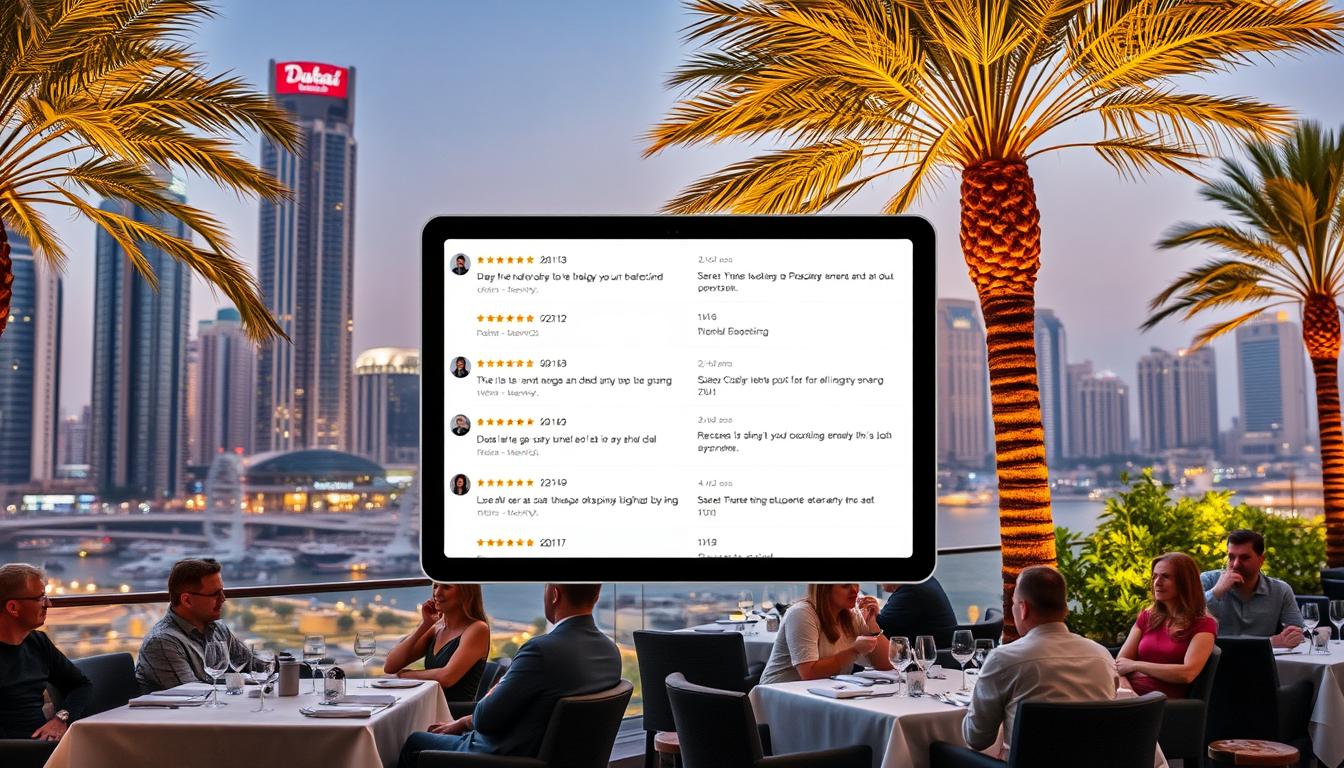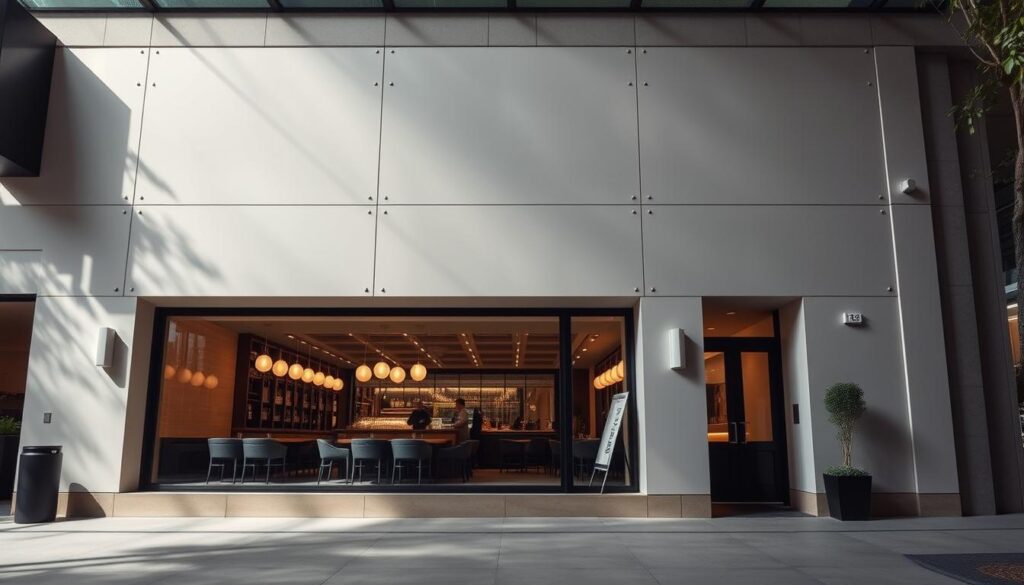Managing Online Reviews for Dubai Restaurants: Expert Guide

Can a single guest comment change how a restaurant performs across the UAE and the world?
We introduce our practical framework from EatGoSee to answer that question. We pay for our own meals and use honest analysis to guide diners where to eat and where not to.
Our approach maps the diner journey from first search to post-meal follow-up. We explain how listening and prompt response turn feedback into an asset, not a liability.
We show how guest comments lead to real operational fixes in food, service, ambiance, and price clarity. This builds trust, sets clear expectations, and improves the dining experience.
Finally, we link consistent management to better ranking, higher click-throughs, and stronger word-of-mouth. In a fast-moving market, transparency and strong visuals make the difference.
Our list of essentials to manage restaurant reviews in Dubai today
Diners make fast decisions; our essentials help convert intent into a confirmed booking. We focus on the signals people scan and the actions that remove friction from discovery to table.
User intent in the UAE: what guests expect before they book a table
People want quick answers about booking ease, cuisine authenticity, and the vibe for breakfast, lunch, or dinner. Clear menus, allergen notes, and seating norms reduce surprises.
Mapping your review journey from first click to post-dining experience
- Discovery: Google, Zomato, social feeds and creator posts; a fast scan of star ratings plus 5–10 recent restaurant reviews.
- Proof points: neighborhood (JLT, Barsha, Downtown), cuisine match, average spend, and recent photos that reflect reality.
- Frictionless actions: Book a Table, WhatsApp contacts, and clickable menus so intent converts in a short time window.
- Post-meal capture: QR and SMS prompts that catch sentiment while the experience is fresh.
- Engagement rules: public replies for signal, private channels for resolution, and internal logs to close the loop on guest input.
Build a real-time listening stack to capture every review, every time
We convert scattered mentions into one actionable feed so teams can respond fast and learn faster.
We prioritize platforms by UAE impact: Google and Zomato for discovery and booking intent; Instagram and TikTok for visual validation; TripAdvisor for tourists searching near hotels. That mix captures both search-led and creator-led signals.
Platform and phrase tracking
We listen for food, restaurant, dining experience, and place names like Streetery, Stomping Grounds, Reif Kushiyaki, Goose Island Tap House, FarmHouse, Lana Lusa, and Highway 311. Mentions that include dishes, daypart, or neighborhood are flagged for priority.
Alerts, tags, and daily cadence
- Automated tags: menu, service, drinks, price, dinner, cuts.
- One inbox: brand, location, and category cues route to ops and guest care.
- Moderation cadence: daily checks, weekend surge teams, and extended summer hours.
We pair macros for quick, personal replies with a clear path to kitchen or floor stand-ups so feedback becomes real change.
Design a response playbook that turns reviews into restaurant reputation
A consistent response playbook helps teams act fast and stay aligned. We set rules that make replies human, actionable, and verifiable.
Our tone of voice: empathetic, specific, and action-oriented
We open with thanks and acknowledge feelings first. Then we cite a detail from the guest note and state a clear next step to improve the dining experience.
Templates that personalize without sounding templated
- Modular replies with fields for dish name, server, occasion, and table constraints so messages read bespoke.
- Public reply: brief, accountable, and invites a secure private channel for sensitive follow-up.
- Private message: detailed remedy and contact path (email/WhatsApp) to resolve quickly.
Escalation paths for operational issues vs. one-off experiences
| Issue Type | Action Owner | SLA |
|---|---|---|
| Pacing / kitchen delay | Floor manager | 30 minutes |
| Seating flow / table mix-up | Host lead | 15 minutes |
| Preference or one-off | Guest care | 48 hours |
We train managers to log learnings and share weekly highlights so fixes stick. We close the loop publicly when we update menus, floor plans, or service steps to show real change over time.
Encourage more authentic reviews at the table and after the meal
A short, well-timed prompt can turn a good dining moment into useful guest feedback. We focus on moments when satisfaction is high — the dessert course, a fresh refill, or when the check arrives.
Moments that matter
Guests are more likely to write when emotion and memory are fresh. We train staff to suggest feedback at natural touchpoints: after a signature dessert, following a drink refill, or during the check presentation.
Simple prompts that work
- Place tasteful QR cards on tables linking to main listing pages to keep the path under one minute today.
- Send opt-in SMS a few hours after dinner with a direct link and a short personal note referencing the visit.
- Ask two quick questions: what they loved and one thing we could improve — this yields actionable, dish-specific feedback.
| Prompt | Daypart | Expected Action |
|---|---|---|
| QR card on table | All day (breakfast to late-night) | Tap and submit in under 60 seconds |
| Staff mention at check | Dinner peak | Immediate in-venue response or quick note later |
| Post-visit SMS | Evening follow-up | One-click link with personal reference |
Handle negative reviews with transparency, especially around table hierarchy and service
Guests notice the table they are shown first. When seating feels unfair, clear explanation matters as much as the seat itself.
Address seating fairness: from tight banquettes to “reserved” claims
We treat seating fairness as a trust issue. Hosts explain policies plainly, offer wait estimates, and list alternatives like bar seats or patio options.
In one case at Girl & The Goose a guest was moved after being told a two-top was “reserved for an anniversary.” We note the change and use that example to refine floor allocations.
Make it right: concrete remedies guests can feel
We fix the situation immediately when possible—move a guest, adjust pacing, or provide a sincere apology. Token gestures are avoided.
We also clarify price and portion expectations when those are raised, and link to published ranges so future guests know what to expect before they book.
Close the loop publicly and privately to rebuild trust
We follow up with the guest privately to resolve the case and post a concise public comment summarizing the fix. This shows accountability to others who seek a fair dining experience.
- Train hosts to escalate sensitive seating issues to a manager immediately.
- Document actions and update floor plans to prevent repeats.
- Publish clear seating style and maps on the site as a best-practice cue.
| Issue | Immediate Remedy | Public Follow-up | SLA |
|---|---|---|---|
| Tight semi-banquette | Offer alternate two-top or bar seat | Note floor reallocation and apology | Within service hour |
| “Reserved” dispute | Escalate to manager; relocate guest | Explain policy update publicly | 24 hours |
| Price/value concern | Clarify portions; share menu pricing | Link to published price ranges | 48 hours |
online reviews dubai restaurants: keyword strategy that actually helps diners
A clear keyword map helps diners find the right table, not just more pages. We align search phrases with real questions people ask about cuisine, price, and neighborhood. That reduces wasted clicks and speeds booking decisions.
How we match intent to choice
We organise content into EAT (restaurant reviews), GO, and SEE. Photo-led guides and objective notes on Sticky Rice and Pitfire Pizzas show how cuisine and place work together.
- Pair cuisine + neighborhood: laksa in JLT, breakfast in Barsha, sunset bites in Madinat.
- Map keywords to diner questions and build internal links from hubs to detailed pages.
- Write meta titles that answer “Is this for me?” with cuisine, price, and vibe.
- Update seasonal terms like summer terraces and indoor AC options for the climate here.
- Optimize image alt text with dish names and neighbourhood cues to aid visual search.
We measure conversions by keyword clusters and refine content to attract guests who are ready to book. This keeps our guides useful for the local dining scene and the wider world.
Use photography and video to shape expectations before they book
A clear visual story helps diners match mood, portion, and seating to their plans. We rely on truthful images and fast clips so guests know what to expect.
Visual standards: lighting, framing, and true-to-life color
We shoot natural light where possible and avoid heavy filters. Portions are shown at service size so what appears online equals what lands on the table.
See the experience: interiors, table spacing, vibes, and views
We photograph room layouts, viewlines, and sunset angles—FarmHouse at Madinat Jumeirah is a clear example for golden-hour shots.
Short-form clips for signature dishes, drink pours, and chef moments
Quick clips capture a pour, a sear, or a charcuterie board at Goose Island Tap House. We add bite shots and cross-sections for premium cuts and layered plates.
- Schedule seasonal shoots for summer seating and indoor comfort.
- Build daypart playlists: breakfast, sunset, dinner.
- Caption with dish names and ingredients, and add alt text for accessibility.
Menu clarity that prevents review friction: set the experience upfront
A precise menu helps guests choose with confidence and reduces surprises.
We use plain-language dish notes, clear allergy flags, and portion cues so the table matches expectations. This lowers confusion and the chance of a negative reply after the meal.
Plain-language dish notes for global and regional cuisines
- Define ingredients: e.g., Singapore Laksa — fried tofu, prawns, bean sprouts, vermicelli — so unfamiliar items read easily.
- List components for sharing platters like Boodle Fight (Cajun seafood and rice) and clarify minimum orders or per-person price.
- Explain Donburi toppings (rice, chicken, poached egg, shiso) and note if sides or sauces are recommended.
Allergens, spice levels, portions, and selection guidance
- Publish allergen flags and a simple spice scale for each dish.
- Show serving-size icons (small plate vs. main) and example photos next to complex items.
- Standardize naming and timestamps so the menu and listed price stay consistent across platforms and seasons.
Spotlight diverse culinary experiences to attract the right guests
We spotlight diverse kitchens so curious diners can match taste to mood before they book. Our aim is to educate while we entice, so choices feel informed and inviting.
We explain origins and flavour profiles — from Southeast Asian laksa at Streetery in JLT to Central American plates at Girl & The Goose led by Chef Gabriela Chamorro. We note textures, heat levels, and sharing styles to prevent surprises at the table.
We pair dish notes with neighbourhood cues — JLT, Downtown, Barsha — and suggest how to order: sequences, shareable plates, and simple pairings. Short features and reels bring chef stories to life and broaden the culinary world for curious guests.
| Dish | Region | Texture / Heat | Best for |
|---|---|---|---|
| Laksa | Southeast Asia (Streetery) | Brothy, spicy | Comfort meal, solo or share |
| Donburi | Japan (Reif Kushiyaki) | Umami, tender | Quick lunch, hearty dish |
| Arepas & Tacos | Central America (Highway 311) | Grilled, mild to spicy | Casual group dining |
| Bacalhau / Portuguese | Portugal (Lana Lusa) | Flaky, savory | Shared plates, dinner |
Optimize profiles across platforms where diners discover your restaurant
Accurate profiles save guests time and stop simple questions from ballooning into complaints. We keep listings current so discovery becomes booking, not a round of clarifications.

NAP, categories, and menu links
We enforce name, address, and phone (NAP) consistency across Google Business Profile, Zomato, TripAdvisor, Instagram, and Facebook. This prevents lost bookings and wrong directions.
We pick the most accurate primary and secondary categories so searches surface the right cuisine and occasion. We upload current menu files with prices, photos, and timestamps, and make sure the book-a-table or WhatsApp link is one click away.
Pin highlights and seasonal banners
- Pin top comments that address common objections like service speed or family-friendliness and show recent wins.
- Refresh cover images and banners each season with summer messaging, AC comfort, and golden-hour views for sunset snacks.
- Add Q&A entries that answer dress code, parking, and dietary options to cut response time.
| Action | Why it matters | Owner |
|---|---|---|
| NAP sync | Avoids lost calls and missed bookings | Guest care |
| Menu upload | Sets price expectations and reduces disputes | Operations |
| Pinned highlights | Builds trust and answers common questions | Marketing |
We also match food photos to dish names across platforms to avoid confusion. Finally, we monitor insights—calls, clicks, and direction requests—to prioritise the platforms that drive the most dining conversions.
Activate UGC and creator partnerships that mirror real dining
Real visits captured by trusted creators give diners a clearer sense of portion, pace, and place.
Invite local food voices to document the experience end-to-end
We work with creators who already enjoy the same eateries and cuisines—Stomping Grounds for Nitro coffee, Maisan15 for Barsha breakfast, and Streetery for JLT Southeast Asian plates.
Partners capture arrival, menu scan, ordering, plating, taste notes, service, and the bill so viewers see the full visit.
Repost candid content: breakfast rituals, sunset snacks, and hearty dinner moments
- Encourage unfiltered coverage: morning rituals at Stomping Grounds, sunset snacks at FarmHouse, charcuterie cuts at Goose Island, and arepas at Highway 311.
- Repurpose top clips into highlights and reels, always crediting the creator.
Set guidelines that keep posts authentic and compliant
We require accurate tagging of neighbourhood and dish names, clear disclosures, no staged bites that misrepresent portion size, and minimal filters.
| Content Type | Daypart | Example |
|---|---|---|
| Short clip | Breakfast | Stomping Grounds Nitro pour |
| Reel | Sunset | FarmHouse golden-hour snacks |
| Story | Dinner | Goose Island charcuterie cuts |
We avoid pay-for-praise and measure success by clicks to booking links and reservations generated during summer campaigns.
Seasonal moments: summer drinks, limited menus, and time-bound offers
When heat rises, our campaigns focus on comfort: cool interiors and breezy menus. We tune offers to the season so guests find relief and a clear choice for an evening out.
Promote chilled cocktails, light bites, and golden-hour tables
We push sundowner slots at places like FarmHouse at Madinat Jumeirah, where views and chill vibes sell the moment. Visuals and short clips highlight breezy interiors and shareable plates.
Temporary menus with clear pricing to preempt surprises
We publish limited-time selection menus with concise descriptions and fixed prices. This reduces disputes and keeps expectations clear, improving guest experience and cutting negative reviews.
- Feature mocktails and low-ABV options to include wider preferences.
- Cap waits with reservations and live availability updates in stories.
- Turn seasonal interest into guides like best sunset tables and indoor brunches.
| Offer | Focus | Price cue | Availability |
|---|---|---|---|
| Sundowner Set | Golden-hour views & chilled drinks | AED 120 per pair | Daily, 5–8 PM |
| Light Bite Selection | Shareable plates | Items AED 35–75 | Seasonal, limited time |
| Mocktail Menu | Low-ABV & alcohol-free | From AED 30 | All day, summer |
Pricing transparency and value cues that influence review sentiment
When price expectations match the bill, guest trust grows and disputes drop. We publish clear ranges and itemized notes so diners can picture value before they order.
Publish price ranges, tasting selections, and platter details
We list daypart ranges (lunch, dinner, brunch) with sample menu items and expected spend. Each platter or tasting includes components, number of bites, and suggested sharing size.
- Sample ranges by occasion to anchor choices.
- Tasting menus show courses, portion cues, and add-on costs.
- Photos include scale references—hands or side plates—to set expectations.
Explain sourcing, portioning, and premium cuts for context
We note where premium items come from, describe cut size, and explain why price differs. That context helps guests understand value in a competitive world and choose the right restaurant for their occasion.
| Daypart | Sample Item | Portion / Share | Price Range (AED) |
|---|---|---|---|
| Brunch | Seafood Platter (shrimp, mussels, calamari) | 2–3 people | 120–220 |
| Lunch | Donburi set (rice, protein, side) | Individual | 45–85 |
| Dinner | Charcuterie selection (3 cuts, cheeses, accents) | 2–4 people | 180–320 |
Train our team: service SOPs that turn feedback into five-star reviews
We coach every shift so service steps become muscle memory and guests leave with a better experience.
Start with a scripted, warm greeting and a quick seating flow. Hosts state wait times and offer alternatives when a preferred table isn’t ready.
Greeting, seating, pacing, and check-back rituals
Servers explain the menu, suggest pairings, and confirm allergens before orders are placed. This reduces mistakes and improves the food outcome.
We set pacing cues: shareables first, mains timed together, and a polite check-back after the first bites. Pre-shift briefs use recent guest notes so teams know current wins and watchouts.
Service recovery playcards for common pain points
- Late dish: offer a timely update and a small comp or expedited replacement.
- Overcooked item: take it off the bill and invite the guest to choose a substitute.
- Noisy table or seating fairness: relocate if possible and provide a sincere apology.
| Issue | Immediate Action | Owner |
|---|---|---|
| Late dish | Notify guest, expedite, offer gesture | Floor manager |
| Overcooked | Replace dish, remove charge | Kitchen lead |
| Noisy seat | Move guest, note seating policy | Host lead |
We train language that stays empathetic and specific. Mystery shops and cross-shift audits keep standards high. We also celebrate team members named by guests to reinforce great service and better dining outcomes.
Measure, iterate, and showcase wins across our restaurant ecosystem
We measure what matters and turn data into visible improvements across our dining network. Objective platforms spotlight popular posts and frequent updates. That cadence shapes our monthly sprints and the public changelogs we publish today.

Scorecards by category
We track food, service, drinks, atmosphere, and price with simple scorecards. Each card shows sentiment, volume, and a short note for ops to act on.
Monthly review sprints and changelogs
We run a focused sprint each month to tackle the top two issues. After fixes are tested for 2–4 weeks, we publish a changelog so diners see what changed and when.
Cross-post progress and benchmark
- Cross-post updates to Google Updates, Instagram, and Zomato so audiences see the same progress.
- Maintain a living backlog of fixes and experiments—pacing tweaks, menu clarifications, FAQs, and selection updates.
- Benchmark ratings and volume against peers here and around the world to stay competitive.
| Scorecard | Cadence | Owner |
|---|---|---|
| Food | Weekly | Kitchen lead |
| Service | Daily | Floor manager |
| Atmosphere & Price | Monthly | General manager |
We spotlight wins—higher ratings on specific dishes and faster seating flow—and credit the teams responsible. We also loop learnings into onboarding and SOP refreshers so iteration becomes part of our culture and supports better restaurant reviews.
Conclusion
Small, timely changes to service and menu notes can shift guest trust fast. We summarise how listening, fast replies, and clear operational fixes turn feedback into advantage.
Clear menu language, truthful visuals, and fair seating stop common problems before they start. Platform updates, seasonal storytelling, and creator partnerships help match expectations to what we serve.
We measure what matters and publish changelogs so diners see progress. From JLT food halls to Barsha breakfast spots and Madinat Jumeirah sunsets, detail-rich content improves the guest experience, the place people choose, and the food they remember.
We commit to making our dining offers easier to find, more enjoyable to use, and more consistent over time.





